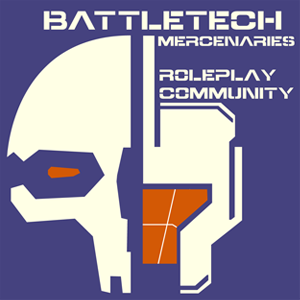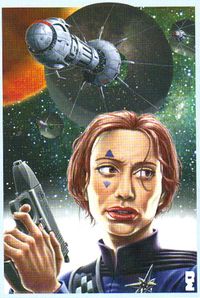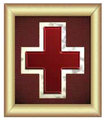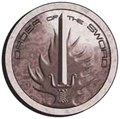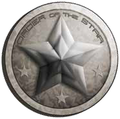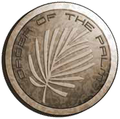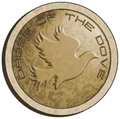Difference between revisions of "Star League Defense Force"
| Line 6: | Line 6: | ||
==Organization and Combat Doctrines== | ==Organization and Combat Doctrines== | ||
| − | At the birth of the Star League, the SLDF was comprised of ~270 regiments of ground forces (conventional armor, infantry and [[BattleMech|BattleMechs]]), as well as a fleet of greater than 500 capital vessels. At the outset of the [[Reunification War]] the SLDF was divided into 10 Corps. | + | At the birth of the Star League, the SLDF was comprised of ~270 regiments of ground forces (conventional armor, infantry and [[BattleMech|BattleMechs]]), as well as a fleet of greater than 500 capital vessels. At the outset of the [[Reunification War]] the SLDF was divided into 10 Corps. Each Army/Corp was named based on its theater of operations and recruitment: |
* First [[Terra|Terran]] Corps/Army | * First [[Terra|Terran]] Corps/Army | ||
| Line 18: | Line 18: | ||
* Second Reserve Corps/Army | * Second Reserve Corps/Army | ||
* Star Guard Corps/Army | * Star Guard Corps/Army | ||
| + | |||
| + | By the [[Amaris Civil War]] the SLDF had over 15,000 regiments and just as many [[WarShips]] and transports.<ref>''The Star League'', p. 105 "Star League Defense Force"</ref> They were organized into 20 Armies divided between 10 military regions.<ref>''The Star League'', p. 133 "Unit Composition"</ref> | ||
| + | |||
| + | * [[1st Army (Star League)]] | ||
| + | * [[2nd Army (Star League)]] | ||
| + | * [[3rd Army (Star League)]] | ||
| + | * [[4th Army (Star League)]] | ||
| + | * [[5th Army (Star League)]] | ||
| + | * [[6th Army (Star League)]] | ||
| + | * [[7th Army (Star League)]] | ||
| + | * [[8th Army (Star League)]] | ||
| + | * [[9th Army (Star League)]] | ||
| + | * [[10th Army (Star League)]] | ||
| + | * [[11th Army (Star League)]] | ||
| + | * [[12th Army (Star League)]] | ||
| + | * [[13th Army (Star League)]] | ||
| + | * [[14th Army (Star League)]] | ||
| + | * [[15th Army (Star League)]] | ||
| + | * [[16th Army (Star League)]] | ||
| + | * [[17th Army (Star League)]] | ||
| + | * [[18th Army (Star League)]] | ||
| + | * [[19th Army (Star League)]] | ||
| + | * [[20th Army (Star League)]] | ||
Though the composition of each of the Corps/Armies differed, a "triangular" organization was maintained though all levels: | Though the composition of each of the Corps/Armies differed, a "triangular" organization was maintained though all levels: | ||
| − | * | + | * An '''Army Group''' consisted of all the Armies assigned to one of the ten military regions. Those assigned to one of the member states were further divided into three districts and bore the name of the state's ruling family, i.e. Army Group [[House Marik|Marik]]. |
| − | * | + | * An '''Army''' consisted of 3-4 Corps. Each of the three districts within each member state's military region was assigned its own Army. |
| − | * | + | * A '''Corps''' consisted of 1-3 [[BattleMech]] Divisions, 2-7 infantry Divisions, several independent Regiments, as well as its own WarShips and transports. Each Corps was usually assigned 30 worlds to protect, though that number could go as high as 100. |
| − | * 1 '''Brigade''' | + | * A '''Division''' consisted of 3 Brigades, support units and an [[ASF]] [[Wing (Military Unit)|Wing]], although some had one more or less Brigade. The Division was the heart of the SLDF, usually charged with protecting a group of star systems within one jump radius, or one important system or planet. Divisions were usually classified as one of the following: |
| − | * | + | ** BattleMech Divisions consisted of 2 BattleMech Brigades and 1 Mechanized Infantry Brigade. These units were primarily considered for offensive operations. |
| − | * | + | ** Mechanized Infantry Divisions consisted of 2 Mechanized Infantry Brigades and 1 BattleMech Brigade. It was the most numerous type of unit and could participate in offensive and defensive operations, although the latter was their more usual function |
| − | * | + | ** Infantry Divisions consisted of 2 Grunt infantry Brigades and a 1 light BattleMech Brigade. They were usually assigned to terrain hazardous to mechanized forces, such as cities and mountains. |
| + | ** Jump Infantry Divisions consisted of 2 Jump Infantry Brigades and 1 BattleMech Brigade, as well as an additional Wing. Jump Infantry were primarily used for quick-strike missions requiring speed and surprise. | ||
| + | * A '''Brigade''' consisted of 3 Regiments, all of the same weight class and capabilities, were also sometimes known as Regimental Combat Teams. | ||
| + | * A '''Regiment''' consists of 3 Battalions and was classified as one of the following: | ||
| + | ** A BattleMech Regiment was typically organized as a Line Regiment, further classified as either ''Heavy Assault'', ''Battle'', or ''Striker''. Independent BattleMech Regiments were designed to operate on their own, and so included non-'Mech Companies such as Jump Infantry or fighters. They were classified as ''Light Horse'', ''Hussar'' or ''Dragoon''. | ||
| + | ** Cavalry, Armored, Aerospace and Naval (CAAN) Regiments were Marine Corps units designed to operate on watery worlds, and so included blue water combat vehicles as well as 'Mechs, hovercraft and fighters. | ||
| + | ** Armored Regiments were classified as either ''Heavy'', ''Medium'', or ''Light'', as well as ''Wheeled'' or ''Hover''. Armored Regiments always consisted of just one type of tank. | ||
| + | ** Artillery Regiments had no separate classification, though some included ''AirMobile Batteries'' with their own air transport. | ||
| + | ** Infantry Regiments were organized as ''Mechanized'', ''Grunt'', ''Jump'' or ''Marine'' units | ||
| + | * A '''Battalion''' consisted of 3 Companies, also know as Batteries if made up of artillery units. Some BattleMech Battalions consisted of the same type of 'Mech, which helped greatly in reducing repair and maintenance problems. | ||
| + | * A '''Company''' consisted of 3 Lances or Platoons for infantry. BattleMech companies were almost always of the same type of 'Mech, though occasionally mixed companies were formed if it members had worked together through one of the Academies but qualified for different designs. The latter were assigned to Independent Regiments. | ||
Revision as of 18:40, 25 April 2011
The Star League Defense Force (SLDF) was the principal military force defending the Star League, a conglomeration of star systems within roughly 500 light years of Terra. The Star League Defense Force left the Inner Sphere after Stefan Amaris overthrew the ruling First Lord of the Star League, Richard Cameron. After fighting a long series of bloody battles throughout the Star League, General Aleksandr Kerensky led nearly seventy-five percent of the Star League Defense Force out beyond the Inner Sphere, hoping to end the internecine violence endemic to the Inner Sphere after the death of Stefan Amaris. The SLDF returned 300 years later as the Clans, a technologically superior military that invaded the Inner Sphere in 3049.
Contents
Organization and Combat Doctrines
At the birth of the Star League, the SLDF was comprised of ~270 regiments of ground forces (conventional armor, infantry and BattleMechs), as well as a fleet of greater than 500 capital vessels. At the outset of the Reunification War the SLDF was divided into 10 Corps. Each Army/Corp was named based on its theater of operations and recruitment:
- First Terran Corps/Army
- Second Rigilian Corps/Army
- Third Altairian Corps/Army
- Fourth Fomalhaut Corps/Army
- Fifth Sirian Corps/Army
- Sixth Astan Corps/Army
- Seventh Procyon Corps/Army
- First Reserve Corps/Army
- Second Reserve Corps/Army
- Star Guard Corps/Army
By the Amaris Civil War the SLDF had over 15,000 regiments and just as many WarShips and transports.[1] They were organized into 20 Armies divided between 10 military regions.[2]
- 1st Army (Star League)
- 2nd Army (Star League)
- 3rd Army (Star League)
- 4th Army (Star League)
- 5th Army (Star League)
- 6th Army (Star League)
- 7th Army (Star League)
- 8th Army (Star League)
- 9th Army (Star League)
- 10th Army (Star League)
- 11th Army (Star League)
- 12th Army (Star League)
- 13th Army (Star League)
- 14th Army (Star League)
- 15th Army (Star League)
- 16th Army (Star League)
- 17th Army (Star League)
- 18th Army (Star League)
- 19th Army (Star League)
- 20th Army (Star League)
Though the composition of each of the Corps/Armies differed, a "triangular" organization was maintained though all levels:
- An Army Group consisted of all the Armies assigned to one of the ten military regions. Those assigned to one of the member states were further divided into three districts and bore the name of the state's ruling family, i.e. Army Group Marik.
- An Army consisted of 3-4 Corps. Each of the three districts within each member state's military region was assigned its own Army.
- A Corps consisted of 1-3 BattleMech Divisions, 2-7 infantry Divisions, several independent Regiments, as well as its own WarShips and transports. Each Corps was usually assigned 30 worlds to protect, though that number could go as high as 100.
- A Division consisted of 3 Brigades, support units and an ASF Wing, although some had one more or less Brigade. The Division was the heart of the SLDF, usually charged with protecting a group of star systems within one jump radius, or one important system or planet. Divisions were usually classified as one of the following:
- BattleMech Divisions consisted of 2 BattleMech Brigades and 1 Mechanized Infantry Brigade. These units were primarily considered for offensive operations.
- Mechanized Infantry Divisions consisted of 2 Mechanized Infantry Brigades and 1 BattleMech Brigade. It was the most numerous type of unit and could participate in offensive and defensive operations, although the latter was their more usual function
- Infantry Divisions consisted of 2 Grunt infantry Brigades and a 1 light BattleMech Brigade. They were usually assigned to terrain hazardous to mechanized forces, such as cities and mountains.
- Jump Infantry Divisions consisted of 2 Jump Infantry Brigades and 1 BattleMech Brigade, as well as an additional Wing. Jump Infantry were primarily used for quick-strike missions requiring speed and surprise.
- A Brigade consisted of 3 Regiments, all of the same weight class and capabilities, were also sometimes known as Regimental Combat Teams.
- A Regiment consists of 3 Battalions and was classified as one of the following:
- A BattleMech Regiment was typically organized as a Line Regiment, further classified as either Heavy Assault, Battle, or Striker. Independent BattleMech Regiments were designed to operate on their own, and so included non-'Mech Companies such as Jump Infantry or fighters. They were classified as Light Horse, Hussar or Dragoon.
- Cavalry, Armored, Aerospace and Naval (CAAN) Regiments were Marine Corps units designed to operate on watery worlds, and so included blue water combat vehicles as well as 'Mechs, hovercraft and fighters.
- Armored Regiments were classified as either Heavy, Medium, or Light, as well as Wheeled or Hover. Armored Regiments always consisted of just one type of tank.
- Artillery Regiments had no separate classification, though some included AirMobile Batteries with their own air transport.
- Infantry Regiments were organized as Mechanized, Grunt, Jump or Marine units
- A Battalion consisted of 3 Companies, also know as Batteries if made up of artillery units. Some BattleMech Battalions consisted of the same type of 'Mech, which helped greatly in reducing repair and maintenance problems.
- A Company consisted of 3 Lances or Platoons for infantry. BattleMech companies were almost always of the same type of 'Mech, though occasionally mixed companies were formed if it members had worked together through one of the Academies but qualified for different designs. The latter were assigned to Independent Regiments.
Combat Role
Ground units of the SLDF were classified and equipped depending upon role.
- Heavy Assault regiments consisted of mainly heavy BattleMechs and vehicles. The main assault force of the SLDF, most corps possessed at least a single Heavy Assault regiment.
- Regular regiments consisted of an equal mix of medium BattleMechs, vehicles, and infantry. Regular regiments were employed for a variety of mission types because they were both mobile and flexible. The majority of SLDF regiments fell into this classification.
- Royal regiments were nearly identical to Regular regiments, with two exceptions. Royal regiments consisted entirely of soldiers of Terran Hegemony birth. Further, Royal regiments are the initial beneficiaries of BattleTechnology innovations - all Royal regiments were equipped with the ultimate in weapons development.
- Horse regiments consisted of light BattleMechs, jump or mechanized infantry, and mobile artillery. Horse regiments remained highly mobile, and excelled at flanking, pinning, harassing fleeing adversaries, and reconnaissance.
- Light Horse regiments consisted of a 7:1 ratio of infantry:BattleMechs. However, infantry within the Light Horse regiments were engineers, anti-BattleMech trained, or commandos. Light Horse regiments were employed for raiding, clearing (or placing) minefields, infiltration, and security.
- Striker regiments consisted entirely of fast BattleMechs, infantry and artillery. All striker units were jump capable (if possible) and armed with energy weapons. Striker regiments were supplied with experienced troops, and were able to conduct missions behind enemy lines for long periods of time.
At the core of all SLDF groups were the Royal Divisions, with troops drawn exclusively from the Terran Hegemony.[3]
A list of SLDF commands is available.
Military Regions
General Shandra Noruff-Cameron, the SLDF's first Commanding General, divided the member states into six Military Regions for organizational purposes.[4] The SLDF stationed an Army Group in the Capellan Confederation Military Region, Draconis Combine Military Region, Federated Suns Military Region, Free Worlds League Military Region, Lyran Commonwealth Military Region and Terran Military Region. The Periphery Military Region oversaw the Periphery nations as a whole, but each Periphery nation was assigned its own SLDF Army.[5]
Second Star League Defense Force
In late 3058, the leaders of the Inner Sphere decided to resurrect the Star League in order to defeat the Clans. Victor Steiner-Davion became the first Commanding General of the SLDF since General Aleksandr Kerensky, though the SLDF was composed of only a handful of units. In 3063, Victor resigned as Commanding General in order to avoid a conflict of interest while he led forces loyal to him against his sister, Katherine. Hohiro Kurita succeeded Victor and presided over the disbandment of the SLDF following a vote of no confidence in the Star League in December of 3067.
Units of the Second Star League Defense Force
Though the ultimate goal of the Second Star League was to create a wholly independent SLDF, due to the small number of so called "core" units, the organization relied heavily upon preexisting units from each member-state. Such units were donated for fixed periods of service and operated per the SLDF Chain of Command. [6]
Eridani Light Horse
As a surviving remnant of first SLDF renowned for maintaining the traditions and history of the original, one of their first acts of the Second Star League was to offer the Eridani Light Horse mercenary unit a place in the new SLDF. The ELH accepted, and made its headquarters in Fort Dieron. In addition, the commanding officer of the ELH was promoted from Brevet General to Lieutenant General.[7]
- Command and Transport Division
- 71st Light Horse
- 151st Light Horse
- 21st Striker Regiment
- 19th Cavalry Regiment
Royal Black Watch Regiment
Born of a centuries old secret society within the Northwind Highlanders devoted to maintaining the traditions of the original Black Watch Regiment destroyed in the Amaris Coup, the new Royal Black Watch again serves as the personal bodyguard of the First Lord.[8]
1st Royal BattleMech Regiment
The first entirely new unit commissioned by the Second SLDF, the 1st Royal BattleMech Regiment was formed by Andrew Redburn from the survivors of many of the commands that were destroyed as a part of Task Force Serpent's assault on Huntress. Most of these troops came from the 1st Kathil Uhlans.[9]
Clan Nova Cat
Pledging their allegiance to the reborn Star League, the Abjured Clan Nova Cat was still a force to be reckoned with, contributing both elite troops and the bulk of their WarShip fleet to the defense of the League. While theoretically the entire Nova Cat touman fell under the control of the SLDF, per their agreement with the Draconis Combine a full third had to be retained within the Combine's borders for the defense of the Cat's Irece Prefecture. [6]
Awards
Uniforms
- Cameronuniformnavaltechnican.png
technican
- Cameronuniformsecurity.png
security
- Cameronuniformmechwarrior.png
mechwarrior
- Cameronuniformnaval.png
naval
- Cameronuniformnaval3.png
naval
- Cameronuniformnaval2.png
naval
- Cameronuniformarmy.png
army
- Cameronuniforminfantry.png
infantry
- Cameronuniformarmor.png
armor
- Cameronuniformaero.png
aerospace
Commanding Generals
| Name | Reign | Rank |
|---|---|---|
| Commanding Generals of the SLDF 2571-2801 | ||
| Shandra Noruff | 2571 - 2575 | General |
| Carlos Dangmar-Lee | 2575 - 2597 | General |
| Nicholas Kinnol | 2597 - 2646 | General |
| Killian Squarn-Turk | 2646 - 2680 | General |
| David Peterson | 2680 - 2707 | Admiral |
| Ikolar Fredasa | 2707 - 2729 | General |
| Rebecca Fetladral | 2729 - 2738 | General |
| Aleksandr Kerensky | 2738 - 2801 | General |
References
- ↑ The Star League, p. 105 "Star League Defense Force"
- ↑ The Star League, p. 133 "Unit Composition"
- ↑ The Star League, p. 41
- ↑ The Star League, p. 41
- ↑ The Star League, p. 133 "Army Group"
- ↑ 6.0 6.1 Field Manual: ComStar, p. 75-76, "The Star League Defense Force"
- ↑ Field Manual: ComStar, p. 84-89, "Eridani Light Horse"
- ↑ Field Manual: ComStar, p. 97-98, "Royal Black Watch Regiment"
- ↑ Field Manual: ComStar, p. 101, "1st Royal BattleMech Regiment (Morgan's Lion)"


